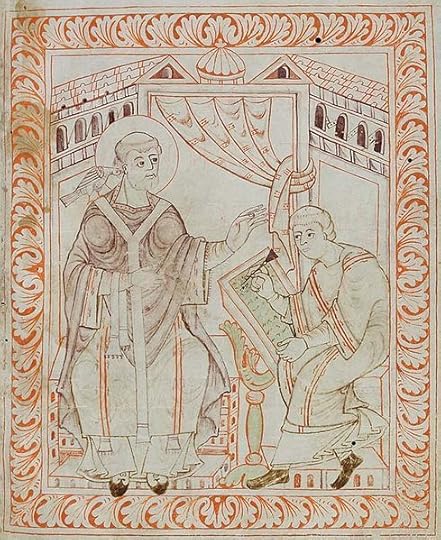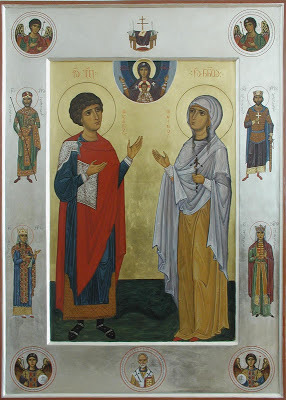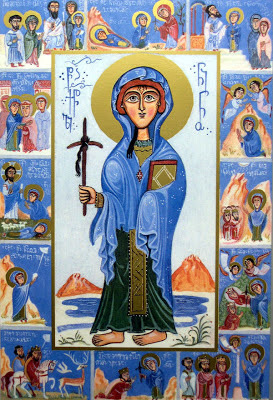Stephen Morris's Blog, page 23
March 8, 2019
“Beware the Ides of March 2019!”
Vincenzo Camuccini, “Morte di Cesare”, 1798,
“Beware the ides of March!” the prophet warned Julius Caesar in 44 B.C. and Caesar was assassinated shortly thereafter, on the ides. Ever since, the Ides of March has been a day associated with doom, disaster, or failure in some form. But what is the “ides”?
Unlike currently used dates, which are numbered sequentially from the beginning of the month, the Romans and medieval Europeans counted backwards from three fixed points: they designated the “kalends,” the “nones,” and the “ides” and all other dates were based on these. (ex. the kalends = the 1st, the nones = the 5-7th, and the ides = the 13-15th days of the month). For instance, rather than saying, “Today is March 3” they would say, “Today is three days before the nones of March.” The kalends marked the new moon, the nones was the half-moon and the ides was the full moon.
The ides of the month marked the full moon and thus the following days of each month were governed by the waning moon, a good time for curses as dark magic grew more powerful as the nights grew darker. Not only would dark magic grow stronger but the darker nights also made crime in general more likely. That the last half of each month was steeped in evil and disaster was underscored by its association with the assassination of Caesar.
Even before the assassination of Caesar, the Ides of March had been important in Roman religion. The Ides of each month were sacred to Jupiter and the Flamen Dialis, Jupiter’s high priest, led the “Ides sheep” in procession along the Via Sacra to the place where it would be sacrificed.
In addition to the usual Ides monthly sacrifice, the Ides of March was also the occasion of the Feast of Anna Perenna, a goddess of the year (Latin annus, hence words like “annual” in English) whose festival originally concluded the ceremonies of the New Year. The day was enthusiastically celebrated among the common people with picnics, drinking, and revelry. One source from late antiquity also places the Mamuralia on the Ides of March. This observance, which has aspects of a scapegoat ritual, involved beating an old man dressed in animal skins and perhaps driving him from the city. The ritual may have been a new year festival representing the expulsion of the old year.
In the later Imperial period, the Ides of March began a “holy week” of festivals celebrating Cybele and Attis, marking first the day when Attis was born and found among the reeds of a Phrygian river. He was discovered by either shepherds or the goddess Cybele (known as the Magna Mater or “Great Mother”). A week later, on March 22nd, the solemn commemoration of Arbor intrat (“The Tree enters”) commemorated the death of Attis under a pine tree. A college of priests, the dendrophoroi (“tree bearers”) annually cut down a tree, hung from it an image of Attis, and carried it to the temple of the Magna Mater with lamentations. The day was formalized as part of the official Roman calendar under Claudius (who died in AD 54). A three-day period of mourning followed, culminating with celebrating the rebirth of Attis on March 25th, the date of the vernal equinox on the Julian calendar.
The post “Beware the Ides of March 2019!” appeared first on Stephen Morris, author.
March 1, 2019
Daffodil, the Flower of March

Associated with Venus and water, daffodil is used to promote love, fertility, and luck.
Daffodil or “lent lily”, one of the early blooming flowers of spring and the flower most associated with the month of March, is a common name for the blossom which is a variety of those called “Narcissus.” It was said by the ancient Greeks to have bloomed where the youth Narcissus withered and died, having become infatuated with his own reflection in a pool. (The goddess Nemesis had cursed him in retaliation for his already self-obsessed and cruel disdain of the mountain nymph Echo. Echo had already been punished by the goddess Hera who had made it impossible for Echo to say anything other than repeat a word or two that someone else had spoken to her. Greek mythology is one big interconnected soap opera, isn’t it?!)
It is associated with the goddess Venus (because of Echo’s love for Narcisscus and Narcissus’ love for himself) and is therefore a “feminine” plant. The alchemists associated daffodil with the element water (perhaps because of its association with Narcissus’ death by a pool, even though the flower itself grows easily in meadows and woods).
If you carry daffodil, it will attract a lover to you. If you place fresh-cut daffodil in your bedroom, fertility will increase. If the bloom is plucked and carried next to your heart, it will attract good luck to you. Good luck and fertility being exactly what Narcissus was himself in short supply of, perhaps his flower is attempting to make amends for him and his bad behavior toward the nymph who wanted nothing more than to be his lover.
IF YOU LIKED THIS POST ABOUT THE FOLKLORE & OCCULT QUALITIES ASSOCIATED WITH DAFFODILS, CLICK HERE TO SEE MY FANTASY NOVELS IN WHICH ALL THE MAGICAL, FANTASTIC, AND SUPERNATURAL EVENTS ARE BASED ON AUTHENTIC MEDIEVAL-RENAISSANCE OCCULT BELIEFS AND PRACTICES.
The post Daffodil, the Flower of March appeared first on Stephen Morris, author.
February 22, 2019
Leap Year is Coming!

An extra day is added to February every 4 years; Julius Ceasar ordered that February begiven an extra day to keep the seasons in balance with the calendar dates.
This year, February has only 28 days. However, next year is a Leap Year and February will have 29 days. It’s time to start thinking about how to observe this day which occurs only once every four years.
For instance, according to an old Irish legend or history, St Brigid struck a deal with St Patrick to allow women to propose to men–and not just the other way around–every four years, on February 29. This was to balance the traditional roles of men and women in a similar way to how leap day balances the calendar. In Scotland however, to ensure success the woman should also wear a red petticoat under her dress–and make sure that it is partly visible to the man when they propose (as red is associated with love and passion).
In some places, Leap Day has been known as “Bachelors’ Day” for the same reason. A man was expected to pay a penalty, such as a gown or money, if he refused a marriage proposal from a woman on Leap Day.
In many European countries, especially in the upper classes of society, tradition dictates that any man who refuses a woman’s proposal on February 29 has to buy her 12 pairs of gloves. The intention is that the woman can wear the gloves to hide the embarrassment of not having an engagement ring. During the middle ages there were laws governing this tradition.
Also in Scotland, it used to be considered unlucky for someone to be born on Leap Day, just as Friday 13th is considered an unlucky day by many. Greeks consider it unlucky for couples to marry during a leap year, and especially on Leap Day.
Leap Day is also St. Oswald’s Day, named after the archbishop of York who died on February 29, AD 992. His memorial is celebrated on February 29 during leap years and on February 28 during other years.
According to the Guinness Book of Records, there is a family that holds the world record of having a baby born on February 29 for three generations in a row!
The post Leap Year is Coming! appeared first on Stephen Morris, author.
February 15, 2019
St. Valentine AND St. Hyacinth

Hyacinth and bluebells are traditionally associated with love and fidelity, telling the truth — and rabbits!
“Saint Hyacinth!” Who’d athunk it?!
Last year, a reader of Romanian background remarked that a post about St. Valentine and love magic made no reference to Eastern European legends or practice. She asked, “Who is the Orthodox version of St. Valentine?” I decided to look into that question and discovered that St. Hyacinth is the Eastern European answer to St. Valentine!
It seems that there are several men named Hyacinth in the Orthodox calendar of saints. The one most consistently associated with love, like Valentine, was a martyr who was put to death for his faith with his brother Protus during the reign of the emperor Trajan (AD 257-9). They were baptized as adults, spent time living with the hermits in Egypt, were beheaded for their faith, and buried together in one tomb. Their brotherly devotion to each other is one source of their association with matchmaking and love.
But that’s not the end of the story. Hyacinth and Protus are said to have been “brothers,” a frequent euphemism for male partners. Such male partnerships first developed among monks as a way to support their mutual prayer, Bible study, and ascetic effort. Among laymen, this “brotherhood” might or might not have included a sexual aspect. (I highly recommend Claudia Rapp’s excellent study of brother-making if you are interested in learning more about this.)
But that is still not all of the story. St. Hyacinth is also associated with love and devotion because the original Hyacinth, a male character from Greek mythology, was a beautiful young mortal man who was beloved by both Apollo (the sun god) and Zephyrus (the god of the west wind). According to the myth, Zephyrus became jealous of Apollo and angry at sharing the attentions of Hyacinth — Hyacinth was evidently more fond of Apollo. So one day as the three were throwing a discus (not unlike three friends tossing a Frisbee), Zephyrus caused the wind to blow the discus into Hyacinth’s head. Hyacinth died of the gash to his head and the first bluebells (also called “hyacinth”) bloomed where his blood spattered the ground. The small blossoms of the flowers are marked by dark spots that resemble the Greek letters AI, which spell the word “Alas!” in Greek.
Hyacinths and bluebells are said to prevent someone from telling a lie just as Hyacinth was honest about his feelings for Apollo. The flowers are also used to promote love and fidelity. They were used in folk medicine but the bulbs contain toxic drugs and are not usually used any more. They are sometimes called “harebells” because rabbits are frequently seen where the flowers bloom and are said by some to be used by witches as they transform into were-rabbits.
There is a wonderful series about bluebell and hyacinth folklore here.
And what about Eastern European love magic? I found a great article about contemporary folk magic in an area where Serbia and Romania meet.
The post St. Valentine AND St. Hyacinth appeared first on Stephen Morris, author.
February 8, 2019
St. Valentine’s Day 2019

The skull and other relics of St. Valentine, a priest martyred in Rome during the early centuries of Christianity, now kept on a side altar in the Basilica of Santa Maria in Cosmedin in Rome.
With the modern celebration of Valentine’s Day nearly upon us, can thoughts of love magic be far behind? A number of traditional ways to win another’s heart have been used over the years. One way a woman could win a man’s heart was by feeding him food into which she had mixed some of her own blood (menstrual blood was especially effective). Catching the reflection of mating birds in a mirror on Thursday was the first step in a more complicated love spell. After catching the reflection, a person would give the mirror to his or her chosen and once the receiver looked into the mirror, they would be irresistibly infatuated with the mirror-giver. (Both of these methods are employed by different women in Come Hell or High Water.) Or a woman might resort to the much more simple use of caraway seeds, cloves, or coriander to win the affection of the man she had chosen. One English love potion included the kidney of a rabbit, the womb of a swallow, and the heart of a dove while an ancient Greek love potion used a stallion’s semen or a mare’s vaginal discharge.
Garlic, saffron, ginger, or even vanilla(!) were more likely to be used in erotic magic, which was less concerned with affection, and more likely to be aimed by men at women. Wax images could be pierced by pins to incite lust. Striking the intended with hazel or willow branches was also thought to inspire lust. Or you could obtain a few hairs from your intended’s head, tie them in a knot with twine, and then keep the amulet on your thigh or around your genitals to draw your intended’s attentions.
Of course, there were ways to deflect this sort of magic as well. Lily or lettuce could break love spells or decrease lust and thwart unwanted attentions. Just be sure not to confuse which herbs you feed to which guest at your table!
There is also an interesting article about the development and history of Valentine’s Day by NPR.

It was a Norse custom to give a newlywed couple enough mead (i.e. honey wine) to last for a month. Hence, our term “honeymoon” ti describe the first weeks of marriage.
The post St. Valentine’s Day 2019 appeared first on Stephen Morris, author.
February 4, 2019
Presentation of Christ: The Encounter

This 10th century Byzantine manuscript illumination depicts the Presentation of Christ when he was 40 days old, described inthe Gospel of St. Luke.
In the Eastern Orthodox Church, the Presentation of Jesus–an early episode in the life of Jesus, describing his presentation at the Temple in Jerusalem is described in the Gospel of Luke and which combines the purification rite with the Jewish ceremony of the redemption of the firstborn (Luke 2:23–24)–is celebrated as one of the twelve Great Feasts, and is usually called Hypapante (“Meeting” or “Encounter” in Greek).
In this episode, Christ encounters the elderly Simeon and Anna, representatives of the Chosen People who anxiously await the coming of the Messiah. The emphasis is less on his presentation in the temple (which was to “buy back” the first-born son, a Jewish practice that looks back to the death of the first-born in Egypt) or the purification of his mother (women were considered impure because of the blood shed during childbirth) and more on this face-to-face meeting of Christ and those who look for him. This encounter becomes the model for the encounter between Christ and all those who pray, receive Holy Communion, or otherwise look to meet Christ in the circumstances of their own lives. Simeon and Anna become the model for all the faithful throughout history.
In Western Christianity, there is an additional name for this day: Candlemas. This feast day is also known as the Purification of the Blessed Virgin or the Presentation of the Lord. In the Roman Catholic Church, the Presentation is the fourth Joyful Mystery of the Rosary. Also, in the Latin Rite of the Catholic Church, the Anglican Communion and the Lutheran Church, the episode was also reflected in the once-prevalent custom of “churching” new mothers–coming to church for the first time–forty days after the birth of a child.
The post Presentation of Christ: The Encounter appeared first on Stephen Morris, author.
January 28, 2019
Candlemas (February 2, 2019)=Beginning of Spring

Marking the 40th day after Christmas, Candlemas celebrates the triumph of light/spring over darkness/winter. Candles blessed on this day were among the most powerful talismans available to ordinary folk in the Middle Ages.
Candlemas, the name taken from the custom of blessing the year’s supply of candles on this day, is the 40th day after Christmas and marks the day Jesus was brought into the Temple by the Mother of God and acclaimed by the elder Simeon as “the light of revelation to the Gentiles and the glory of … Israel.” He also told the Mother of God that a sword would pierce her own heart during the ministry of her Son.
Candlemas, attached to the older feast of Imbolc and the quarter-day between Winter Solstice and Vernal Equinox and thus marking the first day of spring, was even more popular than Christmas in many areas (such as those under the influence of Byzantium and Byzantine Christian culture). People would flock to the churches to obtain the candles blessed on this day as the power of these candles to dispel darkness, death, illness, demons, and nearly anything else that might be considered dangerous to humans was widely reputed to make them the most powerful weapons in the medieval arsenal against evil.
It was also common in western Europe for new archbishops or other leading churchmen to receive their pallium (the “stole,” a vestment similar to a scarf that drapes around the shoulders) on this day, woven from wool sheared from lambs on St. Agnes’ day (January 21).

10th century illumination of St. Gregory the Great wearing his pallium.
The post Candlemas (February 2, 2019)=Beginning of Spring appeared first on Stephen Morris, author.
January 21, 2019
St. Agnes in Prague

A view of the St. Agnes convent in Prague; the national museum’s stunning collection of medieval art is displayed here.
In the well-known Christmas carol, “Good King Wenceslaus looked out” from his castle in Prague and saw a poor beggar struggling to get home during a blizzard. The king asked his page if he knew who the poor man was and the page answered that he did; the poor man, the page told the king, that the poor man lived several miles away in a hovel near beneath the bluffs overlooking the river that runs through Prague. The poor man’s house was also on the edge of the forest, near “St. Agnes’ fountain.”
St. Agnes was a Czech princess who was born in AD 1200. She became a Franciscan nun–known as “Poor Clares”–and established a convent along the edge of the river, on what was then the edge of the city, right against the forest and in the shadow of the bluff on the other saide of the river. There was a well and a fountain in the convent courtyard which the nuns used for their drinking water. The convent is now the site where the National Museum of the Czeck Republic displays the collection of medieval art.
The princess shared a name with a much earlier St. Agnes, a young woman who lived inn Rome and who was executed for her Christian faith during the Great Persecution of Diocletian in AD 304; this Agnes refused to marry because she wanted to embrace life as a Christian ascetic. Agnes’ bones are conserved beneath the high altar in the church of Sant’Agnese fuori le mura in Rome, built over the catacomb that housed her tomb. Her skull is preserved in a separate chapel in the church of Sant’Agnese in Agone in Rome’s Piazza Navona.
According to Robert Ellsberg, in his book Blessed Among all Women: Women Saints, Prophets, and Witnesses for our Time,
“…the story of Agnes the opposition is not between sex and virginity. The conflict is between a young woman’s power in Christ to define her own identity versus a patriarchal culture’s claim to identify her in terms of her sexuality. According to the view shared by her ‘suitors’ and the state, if she would not be one man’s wife, she might as well be every man’s whore. Failing these options, she might as well be dead. Agnes did not choose death. She chose not to worship the gods of her culture. …Espoused to Christ, she was beyond the power of any man to ‘have his way with her’. ‘Virgin’ in this case is another way of saying Free Woman.”
This Roman St. Agnes was very popular throughout Europe during the Middle Ages. The well and fountain in Prague might have been associated with a church dedicated to her even before the princess built her famous convent there.
The young woman martyred in Rome was a member of a very prominent and wealthy family, which is why the Roman authorities cared that she had embraced the illegal Christian faith. The princess who became a nun evidently knew St. Clare herself, the founder of the Franciscan nuns and a friend of St. Francis of Assisi. Both women named Agnes–the Roman virgin-martyr and the Czech virgin-princess-nun–live on in the Christmas carol we sing every December.
The post St. Agnes in Prague appeared first on Stephen Morris, author.
January 14, 2019
St. Nina and the Georgians

This 20th century icon of St. Nina shows her holding her cross made of sturdy grape vines.
St. Nina, said to be a relative of the famous St. George who killed the dragon, is thought to be the saintly missionary who brought Christianity to the people of Georgia just as St. Patrick brought Christianity to the Irish. Nina was a young girl of a pious family who was apparently abducted and sold into slavery in Georgia. Her prayers healed both the king and the queen on different occasions. Deprived of any other devotional aids, she made a cross from very sturdy grape vines and is often depicted holding the vine-cross. She has many feast days in Georgia, commemorating various events in her life; her principal feast day is January 14, the anniversary of her death in AD 340, her “birthday into heaven.”
The people of Georgia have a fascinating collection of folklore and tales. According to one story, God decided to make life easier for those who were driven out of Eden and forced to work hard on Earth. After a long time of thinking, God decided to create a beverage that would let people return to Paradise for even a short time. He invited all the angels and the devil to taste his creation: wine.
Everyone liked wine, including the devil, but the devil felt obligated to compete with God. So, the devil created chacha, a potent alcoholic drink made from the remains of crushed wine grapes, and invited God to taste it. God drank one glass of chacha, then a second, a third and a fourth. After the fourth, he said to the devil, “Those who will drink three glasses of chacha may be on my side, but anyone who drinks more than that will be yours!”

This icon depicts St. Nina of Georgia, holding her grapevine cross, with her relative St. George the Great-Martyr.

A contemporary icon from Georgia, depicting St. Nina holding her cross made of grape vines, with scenes from her life.
The post St. Nina and the Georgians appeared first on Stephen Morris, author.
January 7, 2019
The Magi and Their Dream

The magi have a dream in which an angel warns them to avoid revealing the location of the Christ-child to King Herod. So they go home via another route; as a result, King Herod slays all the boys in the region of Bethlehem who are 2 years old or younger.
In the gospel according to St. Matthew, we read that the Magi–the 3 kings–were on the road for 2 years, following the star that announced the birth of Christ to Judea but had to consult King Herod about where in Judea the new-born king might be located. Herod consulted religious authorities and scholars who told him that Bethlehem was the most likely location. He sent the Magi there but asked them to come and tell him where in Bethlehem they found Christ. They did locate Christ, worshipping him with gold, frankincense, and myrrh. (One story says that the gold was later stolen by the two thieves who were later crucified alongside Jesus. Another tradition suggests that Joseph and Mary used the gold to finance their travels when they fled to Egyot from Bethlehem.) But an angel warned the Magi all in a dream not to reveal the location of the Christ-child to King Herod and so they returned home via a different route, avoiding Herod. When Herod realized the Magi were not coming back to him, he ordered all the baby boys in the Bethlehem region to be killed, hoping to eradicate the baby who was the threat to his rule. But an angel had warned Joseph in a dream to take his family to Egypt and so they escaped, just in the nick of time; they returned to Judea only after Herod was dead.
The star the magi had followed was most likely a conjunction of Saturn (indicating the Last Days) and Jupiter (indicating a great king) in Pisces (associated with Judea and the people of Israel). Dreams were taken seriously as visitations of God, the angels, or other spirits. Dreams and astrology were acceptable tools of divination to discover or understand the will of God and were not considered “magic” by most people until fairly recently. But people who had such dreams might become proud or arrogant, telling others how special they were for having received such a visitation from God in a dream; many spiritual teachers had to warn their disciples against taking such dreams too seriously or becoming arrogant because of them. Rules were established for how to interpret such dreams and how much attention they should be given. But dreams can still inspire us or lead to new inventions, as this recent New Yorker article attests.
A shrine of the Three Kings at Cologne Cathedral, according to tradition, contains the bones of the Magi. Reputedly they were first discovered by Saint Helena on her famous pilgrimage to Palestine and the Holy Lands. She took the remains to the church of Hagia Sophia in Constantinople; they were later moved to Milan before being sent to their current resting place by the Holy Roman Emperor Frederick I in 1164.
Read more about the Magi in previous posts here and here.
The post The Magi and Their Dream appeared first on Stephen Morris, author.



